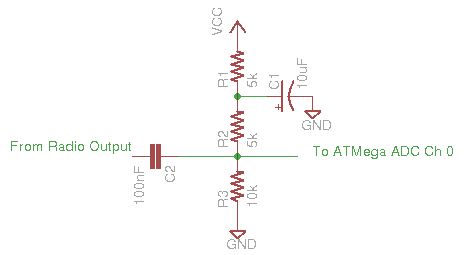
Help us sharing this project:
The project is an AVR ATMega328P based AX-25 1200 AFSK Digital Repeater, suitable for APRS "digipeating". The microcontroller code and the basic Hardware design is based from the BeRTOS APRS example. Check out more information about APRS at Wikipedia.
The most popular AVR ATmega328P board is called Arduino, wich you can either buy one at their website or build your own (the one on the picture is built by me). You can see more pictures of a DIY built Arduino at my Flickr stream.
You can contact the project author at the extradio Google Group (English or Spanish is OK).
At the moment I'm not offering precompiled firmware images, you'll have to build'em on your own. Check out the README.txt file in the source code distribution.
The source code is available in a Mercurial Bitbucket repository: extradio-digi
The hardware design is basically a copy of the original BeRTOS schematic, with an slightly modified resistor divisor for the DC bias on the ADC input:

You can try a similar design using only 10k resistors, by LU4DXT (Thanks!). Both designs should filter DC noise on VCC +5v:

The license is the same as BeRTOS 2.7, GNU GPL v2+:
This program is free software; you can redistribute it and/or modify it under the terms of the GNU General Public License as published by the Free Software Foundation; either version 2 of the License, or (at your option) any later version.
You can read the full license here.
The Arduino hardware can be acquired from the Arduino website.
APRS is a registered trademark of APRS Software and Bob Bruninga, WB4APR.
The BeRTOS project is Copyright 2010 Develer S.r.l. (http://www.develer.com/).
Alejandro Santos (LU4EXT) is the author of the extdigi modification suitable for running the APRS digipeater with an Arduino or an ATmega328 microcontroller.